Chesney Vale - Winton Wetlands

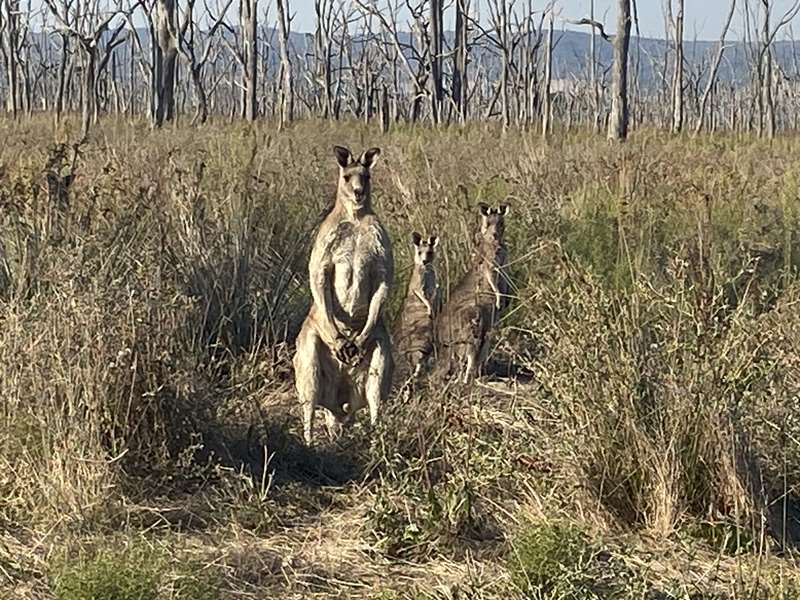
The Wetlands is open visitors every day of the year except on days of Total Fire Ban. Entry to the site is free. Visitors can enjoy a wide variety of activities including bushwalking, cycling, canoeing, bird watching, picnicking, boating and many others.
Winton Wetlands Map

Click or tap to download a pdf version of the map
Mokoan Hub & Cafe
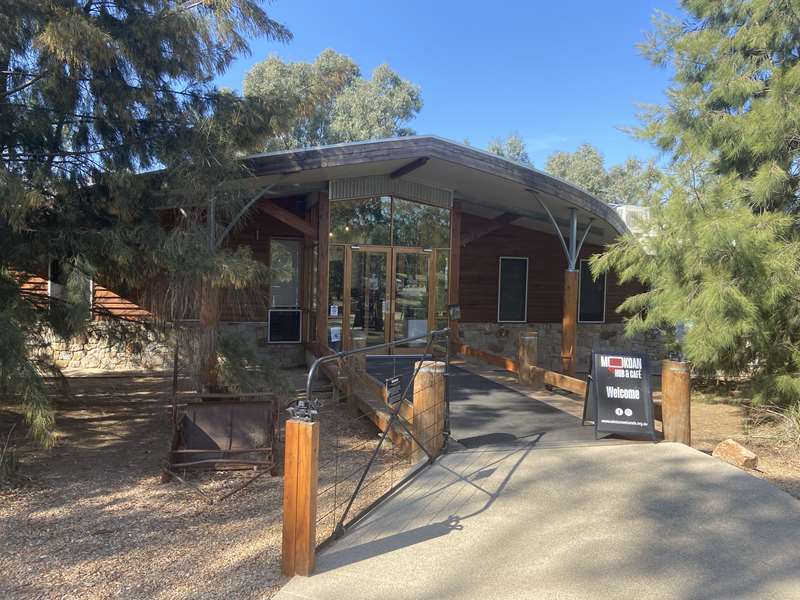
Serving breakfast, lunch and delicious homemade sweet treats with all proceeds going to the ongoing restoration efforts at Winton Wetlands, the Mokoan Hub & Cafe is family friendly with a bespoke nature playground for the kids. A great range of merchandise with a local flair makes for the perfect memento. For bookings (03) 5766 4462.
Flying Fox & Nature Playground
Birds shouldn't have all the fun! Littlies will love whizzing through the air on the flying fox and playing in the nature inspired playground at the Mokoan Hub & Cafe.

Canoeing
- There is no better way to explore Winton Wetlands than on the water. Paddle your way across one of the vast wetlands, taking in the view, not to mention the serenity. A boat ramp on the northern foreshore makes launching easy. Being an ephemeral wetland means the water comes and goes, so we advise contacting the Visitor Hub to check on the water level before planning your adventure.Walks
- The Winton Wetlands offers a range of trails around the Reserve that make exploration safe and easy. A detailed map of the designated walks can be picked up from the Mokoan Hub.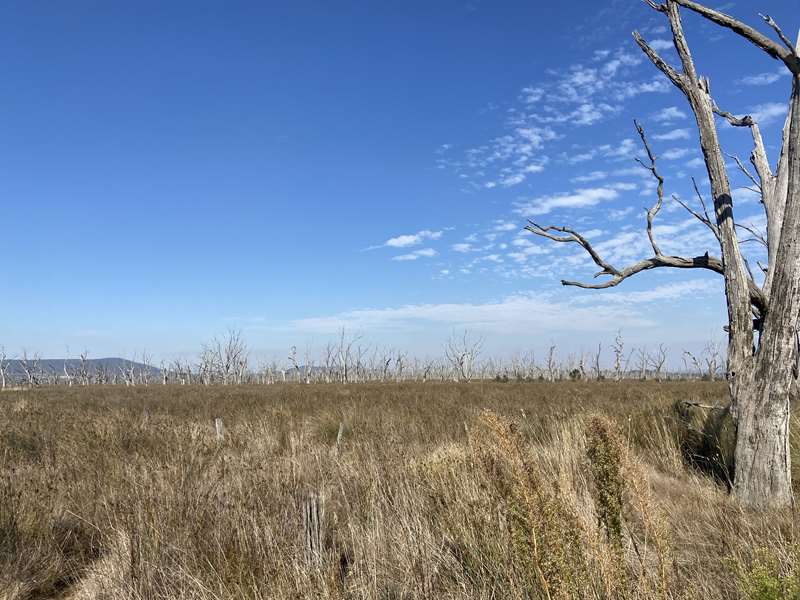
Greens Hill Walk (2.6km)
This walk provides an excellent opportunity to enjoy an elevated look over the wetlands. Explore each phase of the site's cultural heritage through evidence of Aboriginal inhabitants, European heritage and observe the ongoing ecological restoration. Visit the homestead site of the Green family, who farmed and resided here in the 1960s. Keep your eyes peeled and you will hopefully see an array of wildlife, from Yellow-footed Antechinus to a huge White-bellied Sea Eagle.
From the Mokoan Hub & Cafe head right along Lake Mokoan Road for 5.3km. Turn right onto Boggy Bridge Road, travel 3km and where the road bends left, you veer off to the right at Greens Hill entry. Travel a further 700m and you will arrive at the car park on your left.

Woodland Walk (540m)
An easy walk from the Mokoan Hub that showcases a number of woodland species. Hear the many calls of the woodland birds and take in the beautiful box grassy woodland as you explore the layers of Red-gum renewal.
From the Mokoan Hub & Cafe head south along the car park for 700m and you will find further parking at the start of the Woodland Walk.

The Spit Walk (13km return)
Located at the end of a spectacular natural lunette, this isolated part of the wetlands is one of the most beautiful and culturally important. Historically it was a place for gatherings of Indigenous people. Geographically the sandy lunette is the most easterly of its kind in Victoria.
Walking along the sand dune which follows the edge of Winton Swamp, you will have the opportunity to spot a vast array of wildlife especially the birdlife hopefully you will get a glimpse of the White-bellied Sea Eagles. This walking track is not clearly marked and is recommended for more experienced walkers. Follow the tree line along the Spit walk which adjoins the Lunette walk.
From the Mokoan Hub & Cafe head right along Lake Mokoan Road for 5.3km. Turn right onto Boggy Bridge Road and follow to the end of the road. Continue for just over 4km. Pass the Lunette entry and continue to the parking area on your left at Bill Friday Swamp. Start your walk from the entry gate opposite Bill Friday Swamp. Remember if you pass through a gate that has been closed, shut it behind you.

The Lunette (3km return)
A lunette is a rare geological feature - a sand dune found on the edge of wetlands, formed by millennia of sand and soil movement across the swamps, creating a crescent moon shape. This walk showcases the spectacular views over Winton Swamp. This walking track is well marked.
From the Mokoan Hub & Cafe head right along Lake Mokoan Road for 5.3km. Turn right onto Boggy Bridge Road and follow to the end of the road. At the intersection turn right on to Winton North Road. After 4km turn right at The Lunette entry, look out for the tall blue sign. Please be careful as the next 2.6km is not a formed track, you will be passing through grazing areas. Please be aware this track is slippery when wet. Remember if you pass through a gate that has been closed, shut it behind you.
Dam Wall Walk (7.7km)
One of the highest points on the site, the Dam Wall offers a different perspective and is the perfect spot to take in a sunrise.
Humphries Hill Walk (600m loop)
Enjoy a stroll around Humphries Hill, follow the path and explore the history of the area. Keep your eyes peeled as you may spot the signs of Aboriginal occupation in this area. Wildlife can often be found relaxing in this area so take it slow and see what you can spot. This walking track is marked.
From the Mokoan Hub & Cafe head right along Lake Mokoan Road for 5.3km. Turn right onto Boggy Bridge Road and follow to the end of the road bending left at Greens Hill. At the T-intersection turn left onto Winton North Road, after 1.8km Humphries Hill will be in front of you at the right-handed sweeping bend in the road.

Robertsons Hill Walk (660m return)
You are in a secluded area of the Wetlands allowing the opportunity of some great wildlife spotting, This walk is not a clearly marked path to Robertsons Hill. You will venture over some rocky terrain to get to the top of the hill. You will absorb beautiful views over Winton Swamp and Greens Swamp.
From the Mokoan Hub & Cafe head right along Lake Mokoan Road for 3.4km. The parking area is on your right.

Heron Loop Walk (1.1km loop)
Get your binoculars ready, this walk will take you along woodland paths where you may spot a wide variety of wildlife from marsupials to birds. When the Duck Pond is full this area is beaming with life. This walking track is marked with arrows. It follows the north-west edge of the Duck Pond through bush and other areas which may be used for grazing.
Remember if you pass through a gate that has been closed, shut it behind you.
From the Mokoan Hub & Cafe head right along Lake Mokoan Road for 9.4km. Turn right into the Bush Camp at the Duck Pond entrance and park at the end of the track. Your walk follows the fence line north-east, then along the edge of the Duck Pond. Then loop around and head back via the woodland.

Swan Wall Walk (1.5km return)
his walking track follows the wall along the edge of the Duck Pond. A fantastic place for bird watching. Take a seat with you and enjoy spotting the variety of birdlife that gather here when the pond is full.
Remember if you pass through a gate that has been closed, shut it behind you.
From the Mokoan Hub & Cafe head right along Lake Mokoan Road for 9.4km. Turn right into the Bush Camp at the Duck Pond entrance and park at the end of the track. Your walk follows the fence line north-east before heading east along the Swan Wall.
Mokoan Ponds Walk (4km return)
Meander quietly alongside the Mokoan Ponds and you may experience some close encounters with native wildlife. You have a good chance of spotting Black Swamp Wallabies bouncing through the reeds, an Eastern Long-necked Turtle resting in the water or on a log and you may even catch a glimpse of a Rakali [Australian water rat]. This is a fantastic area to spot birdlife too. You may be treated to Pelicans and Black Swans gliding along the water, magnificent Yellow-billed Spoonbills wading through the shallow water, or spot a White-bellied Sea Eagle soaring overhead.
From the Mokoan Hub & Cafe head left along Lake Mokoan Road for 4.4km. Turn into the Dam Wall entrance and drive down to the car park at the Outlet Channel. Walk over the Outlet Channel and turn left at the bottom of the Dam Wall incline, you are now at the Mokoan Ponds walk.

Lotpatj Natjan Danak Sculpture Walk
Lotjpatj Natjan Danak is a creation of cultural works that represent Ancestors; totems and special places; spirituality; ceremonies and cultural practices; histories and knowledge systems; ecology and seasons; plants; insects; birds and animals; rivers; creeks; sky stories and ancient creations.

These works have been created by 15 Yorta Yorta artists to share stories of their living culture.
This is an all-abilities walk across a flat gravel path.
Walk distance: 950m on a loop path
Time to walk: 15 minutes at an easy walking pace
Star Gazing
- An evening under the stars at Winton Wetlands will remain with you long after you leave. Clear, unobstructed skies provide the perfect setting to ponder how insignificant we really are. The Observation Pad on the northern foreshore provides the perfect location to take in the stars. The local astronomy group regularly visit the site.Bird Watching
- With over 188 species of bird recorded at Winton Wetlands, it is a twitcher's paradise. There are many locations within the Reserve where birds can be discreetly observed in their natural environment. Woodland birds, water birds and raptors are regular highlights.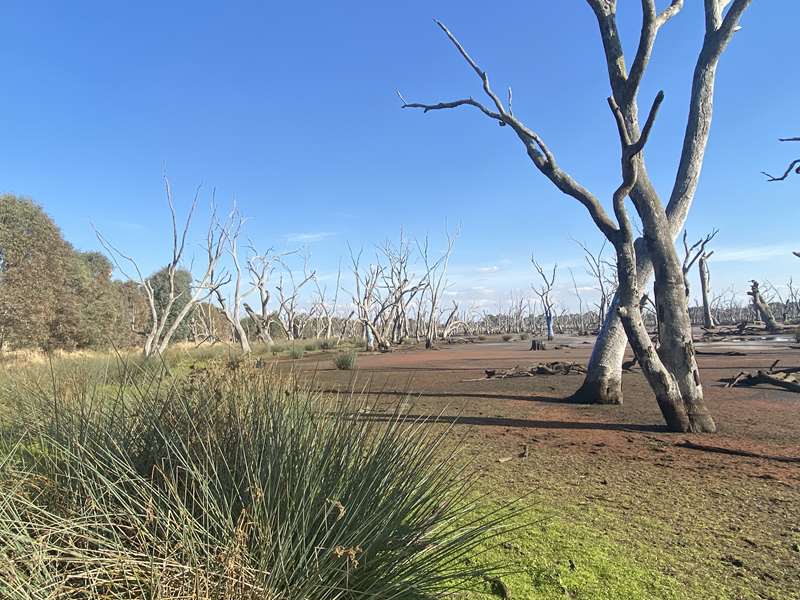
Art in the Landscape
- Uncover stories, new and old. Swim with the fish painted on the trees at Boggy Bridge Road, explore the Water Gallery at Ashmeads Swamp, find Hilda Bain's portrait and the Kaiela Arts Turtle sculpture at The Lunette. The infamous Silo Art Trail CFA Water Tank painted by Guido Van Helten, depicting three local Country Fire Authority volunteers, can be found on Boggy Bridge Road.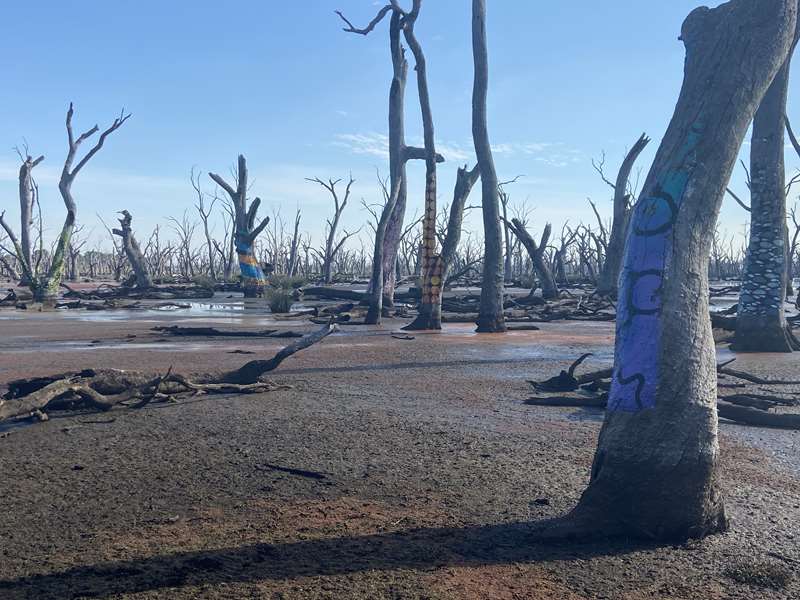
Cycling
- Traverse the paths and take in the scenery at a leisurely pace or arrive at the reserve via the Benalla-Mokoan Discovery Trail. Weave through the skeletal River Red Gum remains, stopping to read the interpretive signage along the way. Collect a Cycling Guide from the Mokoan Hub & Cafe or download from the Winton Wetlands website.Photography
- The ever-changing light and sights across the Wetlands create limitless photographic opportunities.
Facilities
- For most visitors to the Winton Wetlands, the first port of call is the Mokoan Visitor Hub & Cafe. This is located at 652 Lake Mokoan Road.There are also a number of designated picnic locations throughout the site that provide ideal resting points.
Winton Wetlands History
THE DECOMMISSIONING
'Little did I know at the time hanging off the front bumper pushing logs away as my father and I drove along Boggy Bridge Road for the last time, that only 40 years later Lake Mokoan would be drained. The year was September 1970 and my community, North Winton was still hurting from the buy up of good farmland to turn the Winton Swamp into Lake Mokoan.
Farmers were told this was for the 'greater good': extra water for the Goulburn Valley and more water supply for South Australia. 'Short term pain for long term gain' sounded ok - unless you were a family being flooded out destroying your sense of place and 4 or 5 generations of belonging.
1999 the fight to add extra flows to the Snowy River was well underway It was also the State election that saw Victorian Labor Party pledge 27% of flows delivered to the Snowy for incoming Independent Member for East Gippsland, Craig Ingram to secure the election win. This meant all storages were under review.
By 2001 I was getting very suspicious of what the State Government had in mind for Lake Mokoan and I didn't like it one bit. Lake Mokoan needed me more than ever now and I was there for it. More bad news came in August 2001 when at a meeting at the Lake Mokoan Yacht Club a Goulburn Murray Water Spokesperson said they place no value in Lake Mokoan. This was on the same day that my mother passed away. I felt gutted.
My community's worst fears were realised in June of 2004 when Parliamentary Secretary to the Water Minister told a group including myself that Lake Mokoan would be decommissioned and the State Government would put one million dollars towards rehabilitation. What an insult.
After an 18 month study in which I was part of it, had come to this. One might describe the feeling was like watching someone die of cancer knowing all along they were dying but still being shocked when it happens.
The community I had grown up in was now to undergo another huge change some 40 years later, and it was just too much. I doubt many can understand how families flooded 'for the greater good' would be feeling, I couldn't, and I knew a lot of them. I tried my hardest to 'Save Lake Mokoan' as did a lot of others. Those involved had been able to convince the State Government to award $17 million for rehabilitation and tourism development. Yes a lot of money but how you measure the cost of human pain and suffering not once but twice in a lifetime.
Any understanding I may have for this decision came to a stop in March 2010 when the second Minister for Water personally completed the hole in the dam wall.
Please remember Lake Mokoan fondly, and most of all remember the 16 families whose lives changed forever for its creation." Doug Bain, Local identity
In 2007, I was hired as a senior water policy advisor to the State Water Minister and resolving the impasse between department and community over Lake Mokoan was one of my tasks. It was critical to rebuild community trust, starting with locating enough funding up front for the complete wetland restoration project, and freeing the community from the frustrations of begging for money in each government budget amid changing political priorities. Next step was working with the irrigators to come up with a fair deal to secure their water supplies through a mix of water saving infrastructure and strategic buybacks.
I can't say the final package satisfied everyone, and there will always be people who would prefer to have kept Lake Mokoan. But generally, it seemed accepted that the outcome was reasonable, with irrigators paid a premium for water entitlements in recognition that the deal delivered better environmental outcomes than originally envisaged. I wish the community and the Winton Wetlands Committee the best of luck with the restoration project and took forward to seeing a little slice of Eden returning to the edge of the Hume.
Claire Miller
Author Snowy River Story, former Age journalist.
In 1973 Victorian State Rivers & Water Supply Commission released irrigation water rights on the Broken River Irrigation System. It was advertised as the most secure and reliable irrigation in the state as it this was a system that would be serviced by the water storages of Lake Mokoan and Lake Nillahcootie. Irrigation water was allocated, and the government encouraged landholders to develop a business.
We developed a whole farm plan. We steadily improved and grew our business and in 1995 progressed to a 50 stand rotary dairy, milking 600 cows and employing a share farmer and four staff.
However it soon become obvious that the government was considering closure of Lake Mokoan. Many rallies, meetings and protests were held but fell on deal ears.
The decision made by the State Government to decommission Lake Mokoan and have it become a wetland was soul destroying. We felt as though we had wasted close to 40 years of our lives and the huge investment we had made was all in vain. We had lost our business, our livelihood and the pressure, stress and frustration of the process took its toll on our health.
Peter & Lyn Tanner,
Dairy Farmers, Broken Creek.
Political and ecological factors drove pressure to remove inefficiencies in the Murray-Darling Basin system and to put water back into the Snowy River. These pressures drew attention to Lake Mokoan. Decommissioning was first suggested in late 1990s but was actively opposed by local recreational users and irrigators.
Lake Mokoan occasionally dried out and was subject to frequent blue-green algae breakouts. Water managers seeking ways to save water in the Murray-Darting system noted that the large and shallow water body was losing far more water through evaporation than it contributed to agriculture. Inevitably, this raised the question of its decommissioning, with the Victorian Government announcing this in 2004.
The decommissioning of the lake was passionately opposed by many local people and is still resented by many to this day. The decommissioning occurred with the breach to the former Dam Wall in April 2010.
"The decommissioning was fiercely opposed by the Yacht Club and the sailing community but after the announcement in 2009, the club was forced to look at alternatives. In January 2010 the Winton Wetlands Committee, along with Goulburn-Murray Water, finally agreed to buy out the Yacht Club and at the AGM in August that year, the Mokoan Yacht Club was renamed the North East Windsport Club. The club vacated the Mokoan site in November and we relocated to a site near the Wangaratta Airport, encouraging all forms of wind sports."
Michael Reid
Former Mokoan Yacht Club Commodore
MOKOAN SWAMP AND THE INUNDATION
Even the most cursory exploration or this very beautiful, but stark, landscape reveals evidence of the changes and the stories that have shaped rural Victoria, at the same time creating unique, productive and cohesive communities - inspite of a turbulent and sometimes tragic history.
"It was a great place for the ducks because there was cool water under the shade. In the middle, there was the rookery, there were ibis, shags and cormorants. There was a beautiful rookery there. All the water birds used to breed there. That was Green's Swamp"
Les Bain, resident.
Early on the giant natural shallow curved bowl of the area was identified as a potential reservoir that could supply agricultural business in the local area.
Sixteen farming families had their land acquired to make way for the Lake. Fifty-two families lost part of their land. In many cases the affected farming families' existence, their family units and their livelihoods were changed forever.
"Yes, it was absolutely devastating for him [dad] and anybody that was alive at that time would have told you that it killed Jim Nelson. Yeah it did - I don't think there was any doubt about it." He was in the Benalla Hospital and Mum and my brother went in and he said 'Come on lets go home' and my brother said to him 'Where's home?' and he said 'Winton, where else?' ... and that was in hid mind."
Ray Nelson (Jim Nelson's son)
LAKE MOKOAN
Lake Mokoan reservoir impounds the waters of the Broken River and its tributaries for irrigation in Northern Victoria.
Lake Mokoan held approximately 350 gigalitres at capacity. The regional economy grew by $20 million per year as agricultural practices were changed from dry land farming to irrigated farming.
The Lake became extremely popular for recreation. With the stocking of Golden Perch and Murray Cod species, it became one of the best fisheries in Southern Australia. Duck hunting continued to be very popular as the area continued to attract plenty of waterfowl. Many locals have great memories of successful days hunting on the lake and old duck hides can still be seen in the stags around the site.
SPORT & RECREATION AT LAKE MOKOAN
The first recreational users of Winton Swamp were duck hunters, with water fowl hunting taking place at the Winton swamps since European settlement in the 1840s.
The first recorded organised duck hunt on the Winton swamp took place in 1874, which was attended by members of nine local families and by the mid 1880s regular duck hunts were organised. This was seen as a family day out and provided additional food for the table and results of duck hunts were routinely published in local newspapers.
During the mid to late 1970s it was common for Lake Mokoan to be visited by 3,000 to 5,000 duck hunters for the opening of the duck season each March, with duck numbers counted to be in the hundreds of thousands. Noel O'Connor, Benalla Field & Game.
RENEWAL - A NEW FUTURE
Hundreds of people and many partner organisations are involved in this unique rebuilding and renewal project. A shared vision has been developed and plans drawn up to guide developments research and monitoring.
The Winton Wetlands @ Benalla Master Plan contains implementation plans and high-level financial analyses of various proposals for a potential $57million, two-stage development project in the Wetlands. The project aims to restore the Winton Wetlands to a series of interconnected wetlands and grassy woodland areas as it existed prior to its inundation. It will rebuild the ecological integrity to protect and reintroduce threatened species. With the Committee's Restoration and Monitoring Strategic Plan, and over 183 species of birds, an abundance of mammals, reptiles and other fauna and flora, the environmental renewal is well underway.
The Project will re-engage people by capturing and sharing the history of the site. The Wetlands' hundreds of Indigenous cultural heritage sites, as well as the stories and remnants of the European farmers and their community prior to the inundation, are being recorded to share with generations to come.
Photos:
Location
652 Lake Mokoan Road, Chesney Vale 3725 View Map
✆ (03) 5762 1192
Email Enquiry
Web Links
→ www.wintonwetlands.org.au
→ Astronomy Benalla









